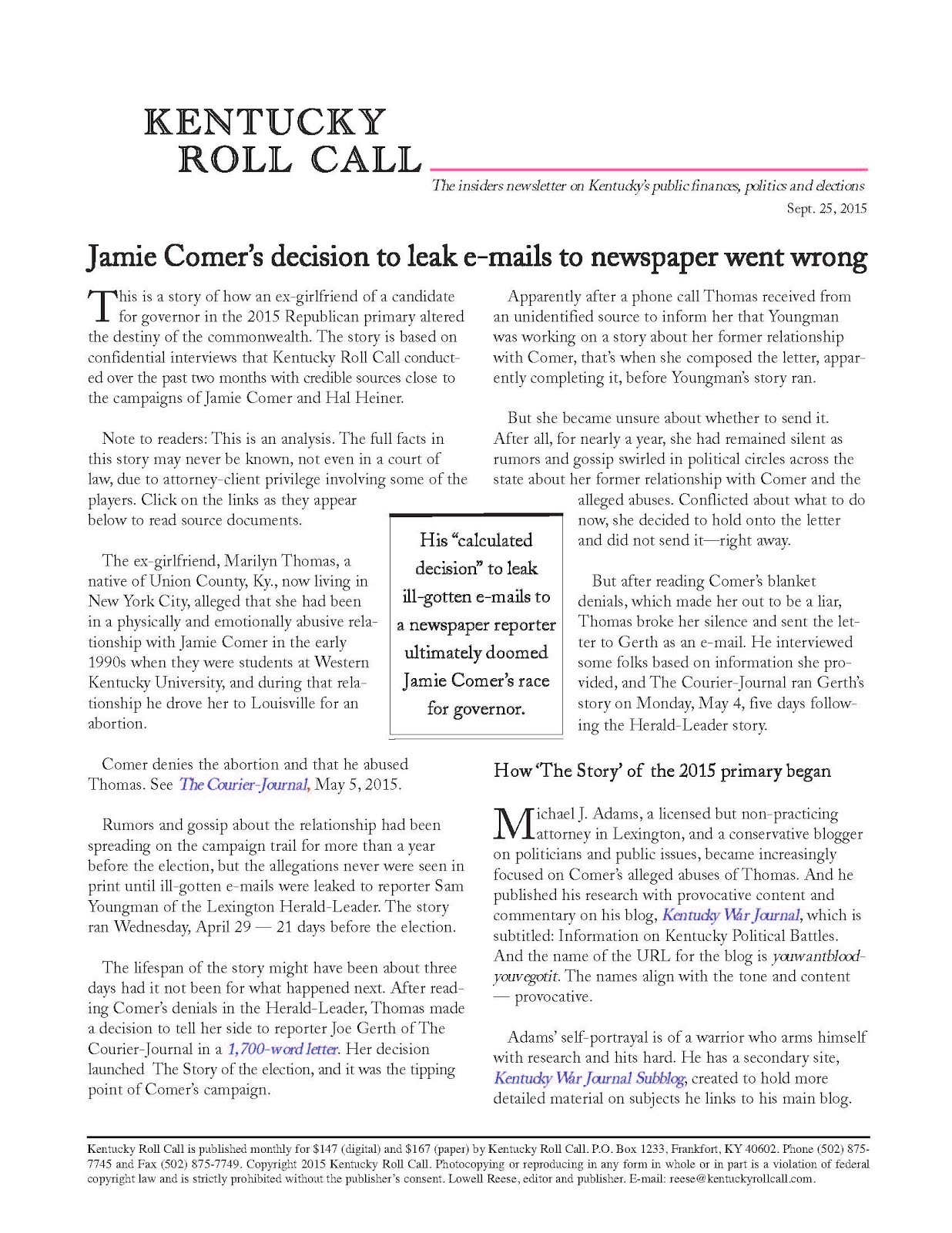Editor's note: The following story ran Oct. 2, 2013 in Kentucky Roll Call.
A former governor
of our state once told Kentucky Roll Call that a governor should always appoint
as secretary of the Finance and Administration Cabinet a person who understands
what he wants without having a conversation about it. That way, if trouble
arises, the governor can say, “I had no part in that decision.” While that may
or may not apply to this story, an appearance of telepathy colors it.
It’s about a
state contract for printing services, and the bidding for it by Lexmark and
Xerox, and the shredding of evidence by the Finance Cabinet.
There were two
RFPs (Requests for Proposal) for this five-year, multi-million dollar contract:
In the first go-round, in 2011, the contract was awarded to Xerox. Lexmark
filed an administrative appeal (protest), which the Finance secretary
ultimately upheld, reversing the award to Xerox, based on a discovery of “error
and prejudice” — the scoring was called into question.
Consequently, the
Cabinet secretary ordered, on March 20, 2013, that the RFP be rebid.
The second RFP,
issued on May 14, 2012, is where we pick it up. The RFP covered “equipment
[printers and copy machines], needs analysis, training, implementation and
maintenance” for the printing needs for all of state government.
Xerox proposed a
cost of $23.3 million, and Lexmark $15.8 million. For Xerox, that comes to
$387,793 a month, and for Lexmark, $262,891 a month — a difference of $124,902
every month for five years, and possibly 10 years.
The total
difference of $7.5 million over the initial term could eventually reach $15
million or more in the event the renewal options are exercised — for roughly
the same product and roughly the same service.
Bidders were
evaluated in three categories: (1) technical proposal, (2) cost proposal, and
(3) oral presentation. Lexmark outscored Xerox in each of the first two
categories by a total of 40 points (3,911 to 3,871).
But on the final
and more “subjective” evaluation, the oral part, Xerox scored 480 out of 500
points to Lexmark’s 400, thus edging out Lexmark by 40 points to win the contract.
On Sept. 24,
2012, the Finance Cabinet awarded the contract to Xerox and, the next day,
directed the members of the evaluation team to shred their score sheets and
other evaluation documentations.
Xerox is a client
of the Louisville-based law firm Stites & Harbison. Before becoming governor,
Steve Beshear was a partner at the firm, and his son, Andrew, is now an
attorney there.
Lexmark filed an
administrative appeal on Oct. 13, 2012. That process would take four months,
until Jan. 18, 2013, when the Finance secretary denied it, clearing the path for
the Cabinet to proceed — to give the contract to Xerox.
Lexmark sued the
commonwealth, the Finance secretary and Xerox in Franklin Circuit Court on Feb.
12, 2013 (Civil Action No. 13-CI-00158), claiming that the secretary’s decision
giving the contract to Xerox was “unlawful, arbitrary, capricious and
unsupported by the record.”
Where the story began
In early 2010,
Gov. Beshear launched a program called Smart Government Initiative, an
innovative effort in which employees would examine the efficiency of state
government and then recommend ways to trim costs. The goal of SGI was “to save
taxpayers dollars,” the governor reasoned.
The employees did
their part; they identified ways to save $7.2 million in the first year alone.
But Lexmark contends paying Xerox $7.5 million more than what it proffered
canceled out the SGI savings.
Destruction of documents
Beyond the
savings question, however, there is a larger issue: the destruction of
documents.
On Sept. 25,
2012, Brenda Brown, an employee in the Commonwealth Office of Technology, an
agency of the Finance Cabinet, sent an e-mail to the members of the evaluation
team, which read, in part:
“The MPS contract has been awarded
to Xerox. I have checked with Stephanie Williams, OPS, and Terry Stephens,
Executive Director — OIS, you may now shed your evaluation documentation, including
any response CDs, paper copies, scorecards and/or other notes. Don’t forget to
delete electronic copies/emails, etc.”
One day after
Brown’s e-mail, Lexmark, on Sept. 26, served its first open records request,
asking for “any and all correspondence, emails, memoranda and other
communications that refer to or relate in any way” to the RFP and the evaluation
and scoring of the bidders.
By law,
government agencies are required to respond to open records requests within
three business days, and then may take an additional reasonable time to gather
the information. In this case, the Brown e-mail would not be made known to
Lexmark until three months later on Dec. 26.
Though the
Cabinet provided an initial response to Lexmark’s open records request, dated
Oct. 18, 2012, which included 12 pages of e-mails, it was not until three
months later, after repeated inquiries by Lexmark seeking additional information
that the Cabinet chose to reveal the existence of the Brown e-mail.
While the
shredded score sheets and other evaluation documentation may have shown how
Xerox came from behind down the stretch to win the evaluators’ hearts, and, therefore
the contract, even though it was significantly higher than Lexmark’s, the
Cabinet, by failing to preserve the full record of this multi-million
procurement, prevented the Court, Lexmark and the public from knowing the full truth
about the contract.
Cabinet defends the shredding
The Cabinet, in
its filings with the Court vigorously defended its order to destroy the
documents. And Donald Speer, an executive director in the Finance Cabinet,
defended the records’ destruction in a story that ran in The
Kentucky Gazette
earlier this year. Speer said, in effect, that the information from the
individual scorers’ sheet, though not the actual score sheets, was used in the
final consensus score, and, therefore, met the legal requirements for records preservation.
Speer said the scorers were told they could get rid of the hefty documents that
were taking up a lot of physical space on their desks and in their offices.
The judge was clearly ticked at the Cabinet
Circuit Judge
Thomas D. Wingate ruled on Lexmark’s case on Aug. 22, 2013, and Lexmark lost
the contract, but not its destruction of documents claim — the judge kept that
part alive.
In his ruling,
Wingate cited an Attorney General opinion, which in turn referenced a court
opinion, contrary to the Cabinet’s view on preserving documents.
In 04-ORD-187,
the Attorney General held that “[w]here the preliminary investigative report or
records are adopted as the basis of the final action taken… [the] records
forfeit their preliminary characterization and must be disclosed.” Preliminary
notes lose their exempt status when “adopted or incorporated into agency
action,” according to the AG opinion.
Further, Wingate
cited a previous court opinion, West v. Goodyear Tire & Rubber Co., that
said, in essence, when a party destroys evidence that could be significant “in
pending or reasonably foreseeable litigation,” the jury is instructed that if
it believes the missing evidence was destroyed “intentionally or in bad faith,”
it may infer that the missing evidence would hurt those who destroyed it.
Such an
instruction to a jury is generally appropriate only when three elements are
satisfied: (1) the destroying party was “obligated” to preserve the evidence;
(2) “the destruction involved greater culpability than mere negligence; and (3)
the missing evidence was relevant to the action. Wingate held that Lexmark
“presented sufficient evidence on all of these elements.”
And, according to
administrative regulation 200 KAR 5:307, pertaining to the retention of records
dealing with state procurements bids, “All evaluation documentation, scoring
and summary conclusions shall be in writing, and made a part of the file
records. …” Moreover, pursuant to the general records retention schedule for
state agencies contained in 725 KAR 1:061, the Finance Cabinet was required to
retain the “Bid Score Sheet File” for eight years.
The quicksand
that the Cabinet stepped into, by destroying the documents, got deeper as the
story unfolded. In his ruling, Wingate held that other retention schedules, and
case law, require “the Finance Cabinet to retain any record required for
current or pending legal action, or where the evidence may be required in a
court case.”
He held that
given the history of the Lexmark-Xerox battle for the contract, “it was
reasonably foreseeable on the day following Xerox’s contract award that Lexmark
would file a protest, as they had done after the first RFP. Litigation was
expected.”
Therefore, in
addition to the judge’s holding that the Cabinet violated the open records law
and destroyed evidence “with a degree of culpability greater than mere
negligence,” Wingate pointed out that the Cabinet should have expected that the
missing documents would be required as evidence in court.
The ruling
In his support
for allowing Xerox’s contract award to stand, Wingate cited the statutory
authority of a Finance secretary to make contract decisions as provided in the Kentucky
Model Procurement Code. He found no fault in
Finance following
the procurement laws, except for the destruction of documents part, which he
viewed as a serious but separate matter — it’s an Open Records issue, not a procurement
code issue, he held.
The judge clearly
rejected the Cabinet’s defense on the missing score sheets and other evaluation
documentation to the degree that he SEVERED Lexmark’s claim about the destruction
of documents, in effect, setting it aside to become a separate action, should
Lexmark choose to pursue it.
That leaves
Lexmark the options of appealing Wingate’s decision and also proceeding with a
separate claim on the destruction of documents at the same time.
Wingate faulted
Lexmark as part of his explanation for upholding the contract award to Xerox.
He said Lexmark failed to exhaust its administrative appeal by not raising the destruction-of-documents
issue in its protest with the Cabinet before filing the lawsuit.
Had Lexmark
followed the judge’s logic and included the issue in its administrative
protest, the Cabinet would have almost surely held that destroying the
documents was not improper, and that would have established a situation
entitling the Cabinet to great deference by the Court under Kentucky law, which
provides that in procurement decisions, the Finance secretary “shall be
entitled to a presumption of correctness.” (KRS 45A.280). So, it was a “Catch 22”
for Lexmark.
Related to the
whole process, including the administrative appeal process, the judge in his
ruling seemed to be saying that he would not be first in reviewing the
“destroying documents” issue — the Cabinet had to have the opportunity to
review it first.
Lexmark had not
made a decision as of our press time as to what its next steps will be.
Lexmark’s only
remedy in terms of the Cabinet’s destruction of documents is through the Open
Records Act, making it hardly worth the effort. At best, it might recoup part of
its attorney fees. And appealing Wingate’s ruling to the Court of Appeals and
state Supreme Court is uphill. The same as Wingate was required by law to grant
the Cabinet secretary the “presumption of correction,” so it is with the different
levels of the courts.
Outlook: We’ve probably heard the last of all of this, unless the attorney
general, state auditor or the legislature develops an interest. #





